
The Gilbert and Ellice Islands in the Pacific Ocean were part of the British Empire from 1892 to 1976. They were a protectorate from 1892 to 12 January 1916, and then a colony until 1 January 1976, and were administered as part of the British Western Pacific Territories (BWPT) until they became independent. The history of GEIC was mainly characterized by phosphate mining on Ocean Island. In October 1975, these islands were divided by force of law into two separate colonies, and they became independent nations shortly thereafter: the Ellice Islands became Tuvalu in 1978, and the Gilbert Islands became part of Kiribati in 1979.
Ten ships of the Royal Navy have been named HMS Royalist:

HMS Egeria was a 4-gun screw sloop of the Fantome class launched at Pembroke on 1 November 1873. She was named after Egeria, a water nymph of Roman mythology, and was the second ship of the Royal Navy to bear the name. After a busy career in the East Indies, Pacific, Australia and Canada, she was sold for breaking in 1914 and was burnt at Burrard Inlet in British Columbia.
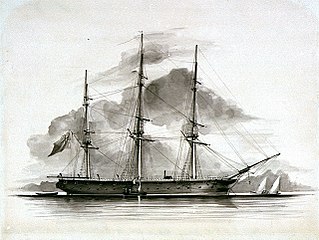
HMS Brisk was a 14-gun wooden-hulled screw sloop designed by the Committee of Reference as part of the 1847 program. She is considered an enlarged Rattler with the design approved in 1847. She was ordered on 25 April 1847 from Woolwich Dockyard as a 10-gun sloop, but the guns were later increased due to the Russian War, to 14 guns by increasing the number of 32-pounder guns. She was launched on 2 June 1851 from Woolwich Dockyard. She served in the Russian War of 1854- 55 and as part of the Southern African anti-slavery patrol, with a final commission on the Australian Station. She was sold in 1870 for use in an pioneer, but unsuccessful, telegraph service.

HMS Penguin was an Osprey-class sloop. Launched in 1876, Penguin was operated by the Royal Navy from 1877 to 1881, then from 1886 to 1889. After being converted to a survey vessel, Penguin was recommissioned in 1890, and operated until 1908, when she was demasted and transferred to the Australian Commonwealth Naval Forces for use as a depot and training ship in Sydney Harbour. After this force became the Royal Australian Navy, the sloop was commissioned as HMAS Penguin in 1913. Penguin remained in naval service until 1924, when she was sold off and converted into a floating crane. The vessel survived until 1960, when she was broken up and burnt.
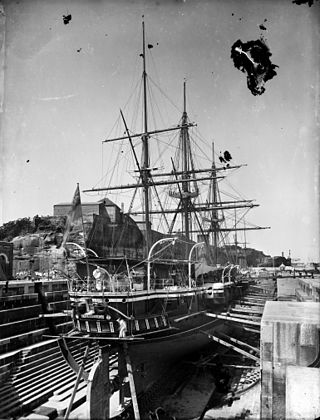
HMS Curacoa was a Comus-class corvette of the Royal Navy, built by John Elder & Co., Govan, launched in 1878, and sold in 1904 to be broken up. She served on the Cape of Good Hope and West Africa Station, the Australia Station and as a training cruiser in the Atlantic.

HMS Swinger was an Ariel-class composite gunboat of the Royal Navy, built at Pembroke Dockyard and launched on 7 February 1872. She served at first on the China Station and from 1883 on the Australia Station. She was hulked in 1895 sold for breaking in 1924.

HMS Raven was a Banterer-class gunboat of the Royal Navy, built by Samuda Brothers of Poplar, London, and launched on 18 May 1882. She served on the Australia Station and was converted to a diving tender in 1904. After being lent as a training ship in 1913 she was sold for breaking in 1925.
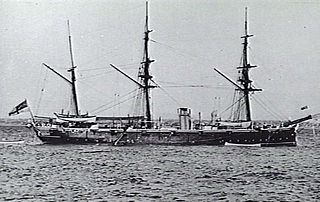
HMS Pylades was a Satellite-class composite screw sloop of the Royal Navy, built at Sheerness Dockyard and launched on 5 November 1884. She was later reclassified as a corvette and was the last corvette built for the Royal Navy until the Second World War.

HMS Rapid was a Satellite-class composite screw sloop of the Royal Navy, built at Devonport Dockyard and launched on 21 March 1883. She was later reclassified as a corvette.

HMS Dart was a schooner of the Royal Navy, built by the Barrow Shipbuilding Company, Barrow and launched in 1877 as Cruiser for Lord Eglinton. She was subsequently purchased by the Colonial Office for the use of Sir Arthur Hamilton Gordon as governor of the Fiji Islands. On his appointment to New Zealand, Cruiser was purchased by the Royal Navy as a tender for the training ship Britannia and the name changed to Dart in March 1882.
HMS Renard was a schooner of the Royal Navy, built by John Cuthbert, Millers Point, New South Wales and launched 16 January 1873.

HMS Basilisk was a first-class paddle sloop of the Royal Navy, built at the Woolwich Dockyard and launched on 22 August 1848.

HMS Miranda was a Doterel-class sloop of the Royal Navy, built at Devonport Dockyard and launched on 30 September 1879.

HMS Espiegle was a Doterel-class sloop of the Royal Navy, built at the Devonport Dockyard and launched on 3 August 1880.
HMS Emerald was an Emerald-class corvette, of the Royal Navy, built at the Pembroke Dockyard and launched on 18 August 1876.
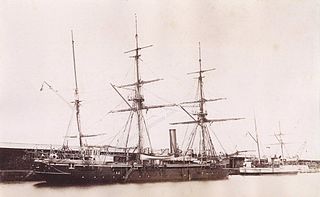
The Algerine-class gunvessel was a class of three Royal Navy composite gunvessels built in 1880. Two of them were sold after only ten years of service, but the other was converted to a survey ship before commissioning and survived in this role until 1907.

HMS Champion was one of nine Comus-class corvettes of the Royal Navy, built in the late 1870s and early 1880s to a design by Nathaniel Barnaby. Champion was one of three in the class built by J. Elder & Co., Govan, Scotland and was launched on 1 July 1878. She was the third vessel under this name in the Royal Navy.
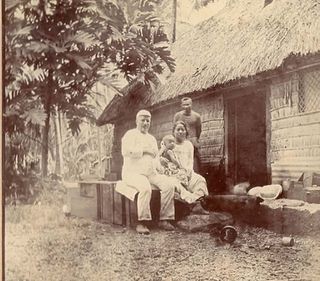
Christian Martin Kleis (1850–1908), known as Martin Kleis, was born in Denmark and died in the Ellice Islands (Tuvalu). Kleis was the resident trader on Nui in the late 19th century.
Admiral Edward Henry Meggs Davis was a Royal Navy captain, then admiral, who served in the Cape of Good Hope Station, Pacific Station, Mediterranean Fleet and the Jamaica Division.
















